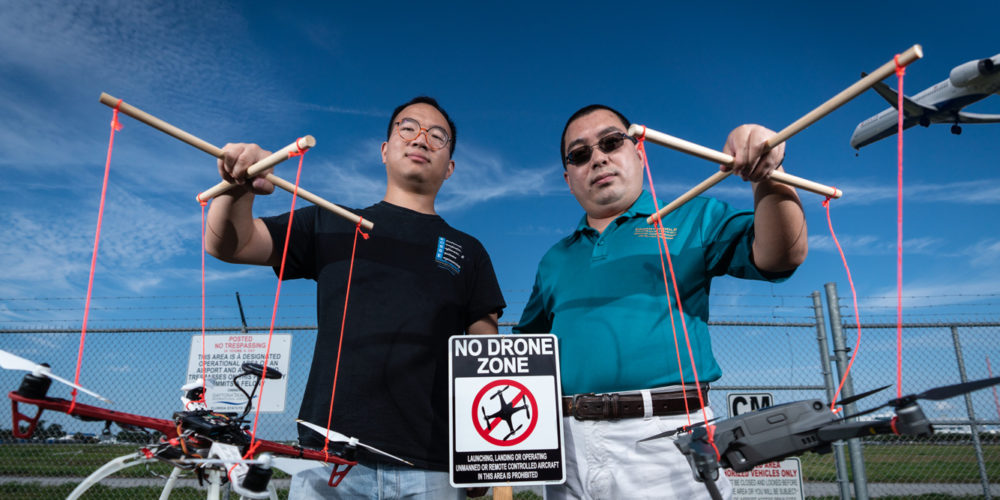By 2022, the Federal Aviation Administration (FAA) expects some 1.1 million small, hobbyist-type unmanned aircraft systems, or drones, to take to the skies — more than twice as many as in 2017.
More drones mean more incursions into sensitive airspaces, particularly in and around airports, and that’s a potential threat to the safe operation of commercial airliners filled with passengers and cargo. While most drone operators undoubtedly strive to fly responsibly, some may be unaware of the rules regarding restricted airspace. A few may even have criminal intentions.
Assistant Professor Houbing Song and Ph.D. students Yongxin Liu and Jian Wang have invented a fix for the problem: a technology that detects and commandeers unauthorized drones.
“Our solution is friendly,” Song says. “Rather than destroying the drone, we guide it to a safe landing place. The technology will counter unauthorized drones effectively, while ensuring low collateral damage and low cost per engagement.”
Song and his students recently teamed up with international entrepreneur Sotirios George Kaminis. The son of a shipping industry leader on the Greek island of Chios, Kaminis fell in love with Embry-Riddle in the 1980s when he attended classes at the Daytona Beach Campus. “In all my travels over the years, I never forgot Embry-Riddle,” says Kaminis, founder and CEO of Drone Defense Systems. “It’s the most prestigious aeronautical university in the world — the perfect partner to bring new counter-drone technology to market.”
Under a newly inked licensing agreement, Embry-Riddle and Kaminis will refine the concept, build a prototype and pursue related products, according to Stephanie A. Miller, executive director of technology transfer for Embry-Riddle’s Research Park.
The Drone Problem
The need for Song’s invention is clear. Near-miss events between drones and aircraft have been on the rise. Last year, unauthorized drones forced a costly shutdown at England’s Gatwick Airport. Reports of drone sightings from pilots, citizens and law enforcement have increased significantly over the past few years, with the FAA now receiving more than 100 such reports each month. In 2018, a separate Embry-Riddle team scanned the skies over Daytona Beach International Airport for 13 days and spotted 73 different DJI-type drones that made 192 separate flights.
Existing remedies for rogue drones range from dispatching birds of prey to shooting bullets, deploying nets or targeting them with channel-jamming electromagnetic noise. Military and corporate drone-jamming technologies do exist, Kaminis says, but the cost of those systems makes them inaccessible for smaller airports or private venues.
By comparison, Song’s system could be manufactured at a far more reasonable price, Kaminis says. It would also work over long distances and in a variety of settings.
This approach offers important advantages, says Kaminis, whose company already markets another counter-drone technology. “My existing product is intrusive — it’s considered a weapon because it jams drones and makes them fall out of the sky. The Embry-Riddle technology is non-intrusive, so it is ideal for civilian applications and easy to export, as it doesn’t fall under ITAR (International Traffic in Arms Regulations).”
‘Listening’ with Artificial Intelligence
Song’s proposed system leverages a network of wireless acoustic sensors to identify a flying drone. To distinguish drones from birds, he and his students built a computer-based “brain,” called a neural network, that is continuously learning. After the system confirms a drone, the acoustic sensors, working in tandem with beacon receivers, transmit information to a control center.
If the drone is on an unauthorized flight, Song’s system uses sophisticated pattern-recognition techniques to decipher its video-streaming channel and interrupt the broadcast with a warning message. “For each drone,” says Yongxin Liu, who is currently pursuing his second Ph.D., “the acoustic pattern might be a little different, but we can tell them apart, just as anyone can distinguish between a songbird and the noise of a crow.”
The system can also hijack the drone’s communication channel to trigger its pre-determined return flight, or otherwise trick the drone into leaving the area, explains Song, who has a background in artificial intelligence and cybersecurity and is the director of the Security and Optimization for Networked Globe Laboratory (SONG Lab) in the electrical, computer, software and systems engineering department.
“It disrupts communication between the pilot and the drone,” Kaminis said. “It detects the drone, finds out what language the drone speaks, activates an emulation system that mimics the drone’s language and snatches control away from the pilot.”
Kaminis is optimistic about the potential for Song’s invention. “When people work together and put their heads together, great things can happen,” he says. “We’re going to make history for Embry-Riddle.”
A U.S. patent application has been filed by Embry-Riddle, Song and his students.
In the 1980s, Kaminis had to leave Embry-Riddle and return to Greece to run his family’s shipping business. He plans now to complete his degree. “I look forward to picking up where I left off and reliving being an Eagle. When I do, I will join my youngest son, Angelos, a current student at the Daytona Beach Campus.”
